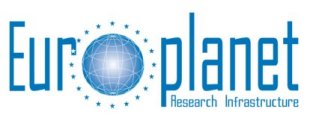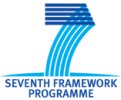Dust Analogue Simulation Facility: production, characterization, processing of dust analoguesProvided by: INAF-Osservatorio Astronomico di Capodimonte Homepage: |
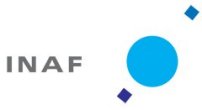 |
Scientific Contact:Dr. Vito MennellaINAF- Osservatorio Astronomico di Capodimonte Salita Moiariello 16 80131 Napoli Italy Phone 00 39 081 5575543 Fax 00 39 081 456710 |
Local administrative contact (once a TNA visit is awarded):Ms F. BencivengaINAF- Osservatorio Astronomico di Capodimonte Phone 00 39 081 5575512 Fax 00 39 081 5575562 |
Facility Description
|
Unique facility: different experimental approaches and set up available to obtain complementary information on dust analogues Production of dust analogues (several techniques: arc discharge, laser ablation, grinding of minerals, ices) The Facility can provide spectroscopic data of analogues on a wide range (UV-mm) The spectral data are integrated with information on morphology (size, shape), chemical composition, and structure It is possible to study (in situ) the spectral evolution of the samples with thermal annealing, UV irradiation and gas interaction |
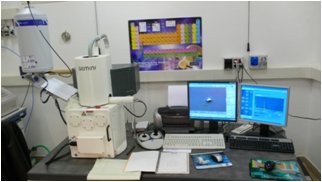 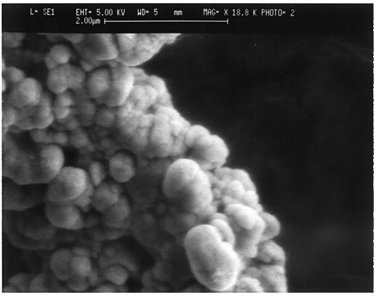 |
Spectrophotometers
|
Perkin-Elmer Lambda 19 equipped with an integrating sphere, operating range 190-3200 nm FT-IR Bruker Equinox 55 with IR microscope FT-IR Bruker IFS 66v operating range(2-2000 mm) with Raman module FT-IR Bruker Vertex 80v operating range (2-2000 mm) ReferencesMeasurements of the extinction efficiency of dust samples (Colangeli et al. 1995) IR Reflectance Spectroscopy of Martian Analogues Derivation of optical constants |
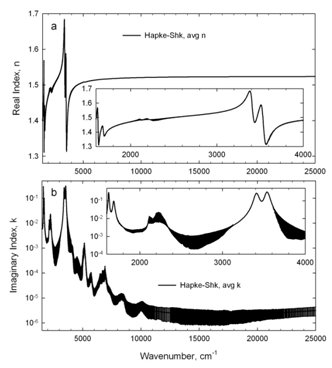 Optical constants of gypsum and associated standard deviation errors derived from reflectance measurements (Roush et al 2007). An expanded view of the infrared region is shown in the inset. |
Electron Microscope
|
Field Emission Scanning Electron microscope Zeiss Supra 25 (resolution 2 nm) EDX analyzer Incax-sight (Oxford Instruments) For preliminary analysis of dust analogue samples (e. g. shape and grain distribution) To characterise extraterrestrial samples ReferencesAnalysis of grains of comet Wild 2 - STARDUST mission |
 FESEM image of a Stardust particle (41,7). It appears very porous and fluffy and may be covered by aerogel particularly in the area indicated by the black arrows. (Rotundi et al. 2008) |
Thermal annealing of dust analogues
|
Vacuum chamber for dust annealing (P< 10-5 mbar). Temperature controller. Sample temperature up to 1300 K Analytical techniques : IR spectroscopy (2-20 mm). To study structural modification induced by heat in different dust materials ReferencesDehydrogenation of hydrogenated carbon grains Amorphous – crystalline phase transition in silicates |
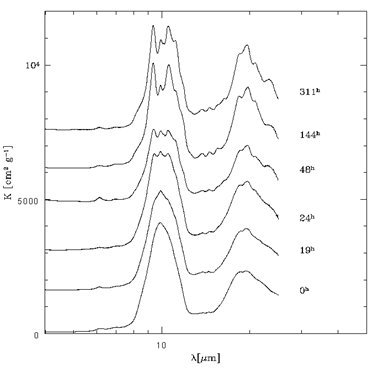 Mass absorption coefficient, K, of Mg-rich pyroxene as produced and after thermal annealing at 800 °C for various time lags (Brucato et al. 1999). |
UV irradiation and atom bombardment of dust analogues
|
UV source: Ly alpha photons produced by microwave discharge of H2. H atom source: Microwave dissociation of H2 Analytical techniques : IR spectroscopy (2-20 mm) ReferencesFormation of CO and CO2 by UV irradiation of hydrogenated carbon grains covered with a water ice layer Molecular hydrogen formation by abstraction of H atoms chemisorbed in hydrogenated carbon grains |
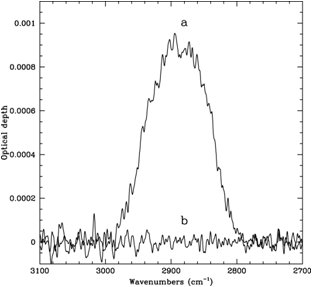 Activation of the 2883 cm-1 (3.47 mm) band after exposure to H atoms of nano-sized carbon grains covered with a water ice layer at 12 K. |
Contact persons
|
Coordinator: Practicalities of visitors |
Alternative contact: Administrative contact: Technical staff contact: |
User Access
Facility address:INAF – Osservatorio Astronomico di Capodimonte AccommodationGuest-house in OAC is available on request for limited time staying depending on availability. In Naples there are a large number of hotels and bed and breakfast for accommodations. Very close to the Observatory (5-10 minutes walking distance) there is the Hotel Villa Capodimonte (http://www.villacapodimonte.it/) How to reach the FacilityFrom the airport From Piazza Garibaldi: With the train By car |
For information on the Europlanet TNA programme contact:
Professor N J Mason, Department of Physics and Astronomy, The Open University, Walton Hall. Milton Keynes, MK7 6AA
Email (preferred method of contact)
